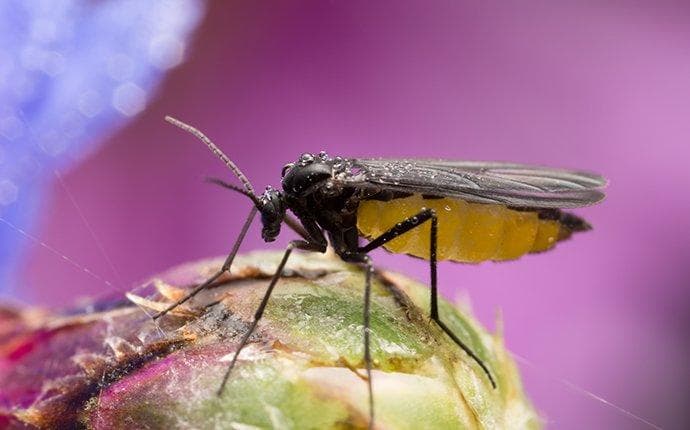Are fungus gnats annoying you beyond belief? We’ve got you covered.
Fungus gnats are an extremely common, extremely annoying pest that plague many who enjoy having houseplants in their home. These tiny, greyish-black, winged creatures are attracted to the moisture in soil that’s created when houseplants are watered, which makes them especially difficult to prevent and eradicate. As adult flies, they are more of a nuisance than a harm to plants; however, the larvae that hatch in soil will feed on your plants’ roots, damage them detrimentally, and even spread fungal plant diseases. Thankfully, they aren’t dangerous to humans – except for the whole ‘annoying’ part.
These gnats can enter your home in a number of ways, but often eggs are already laid in the soil of a new plant you’re bringing home. Once they’re present in your house they can multiply and wreak havoc very quickly, which is why it’s important to catch them early and take preventative measures. Thankfully, there are a number of options you can take when you start to notice these pestering bugs flying around your house.
Solution 1: Replace the top couple inches of soil and change up your watering
Fungus gnats lay their eggs within the first inch of soil, so removing and replacing the top inch or two of soil can help physically remove the fungus gnat eggs and larvae.
Avoiding overwatering your plants and allowing your plants to dry out a little more between waterings can help keep fungus gnats at bay as well. Especially make sure to avoid overwatering during fall and winter; fungus gnats will often move indoors during this time, and the decaying roots that occur when your plants are overwatered make perfect fungus gnat food.
Bottom-watering your houseplants (aka allowing your plants to soak up water from a tray or bowl through their pots’ drainage hole instead of traditionally watering the top of the soil) can also help to prevent these guys. Without the moist climate they thrive in at the top of the soil, it will be difficult for fungus gnats to continue multiplying. You must make sure to remove the tray of water after the plant has sufficiently soaked up what it needs, otherwise more fungus gnats may be attracted to the bottom of your plant instead. Additionally, make sure not to bottom water consistently over time, as it does not allow for the flushing out of excess minerals that top watering provides. It sounds like a lot but, really, it isn’t and you can say you played in the dirt!
Solution 2: Try a DIY Hydrogen Peroxide remedy
Believe it or not, the solution to your fungus gnat problem may already be sitting inside your medicine cabinet. A diluted solution of Hydrogen Peroxide and water poured directly onto the soil will kill fungus gnat larvae on contact and help stop the gnats’ life cycle. Simply mix a 1:8 solution of common 3% Hydrogen Peroxide with the water you would typically use for your houseplants and water thoroughly, until the water runs out of the bottom of the pot. This flush of Hydrogen Peroxide will also help remove excess salts created by overfertilizing. Make sure to use this solution immediately upon mixing.
However, because Hydrogen Peroxide will kill the beneficial microorganisms in your soil, it’s important to keep the plants that were watered with this solution well-fertilized and updated with fresh soil.
You can also use Hydrogen Peroxide to kill the adult fungus gnats in your house by spraying them with a stronger dilution. Mixing a 1:4 solution of 3% Hydrogen Peroxide with water and spraying the stems or leaves where fungus gnats are buzzing around will help kill these pests.
Solution 3: When all else fails, take the strong insecticide route
Sometimes, especially with an intense infestation, home remedies don’t cut it. Using a strong insecticide like Mosquito Bits or Systemic Houseplant Insect Control will help nip these pests in the bud completely.
Mosquito Bits is a bacterial insecticide that will kill both mosquito and fungus gnat larvae. To control fungus gnats, simply spread ½ cup of the granules per square foot of soil and water as usual. The watering will release the beneficial bacteria throughout the soil, which kills the larvae upon feeding.
Systemic Houseplant Insect Control is a powerful pesticide that provides up to 8 weeks of control for a number of pests, not just fungus gnats. The granules are ready-to-use, and all you have to do is spread them evenly on the top of the soil, mix them into the first inch of soil gently, and water thoroughly. This will also help kill mealybugs, scale, thrips, whiteflies, aphids, and more. However, because of the strength of the chemicals present, the granules do need to be handled with caution. Make sure to follow the instructions on the product manual carefully.
At For Garden’s Sake, we carry both of these insecticides. If you have any more questions about combatting fungus gnats or any other pest plaguing your houseplants, please feel free to give us a call or come visit! We are happy to help answer any questions you may have.

